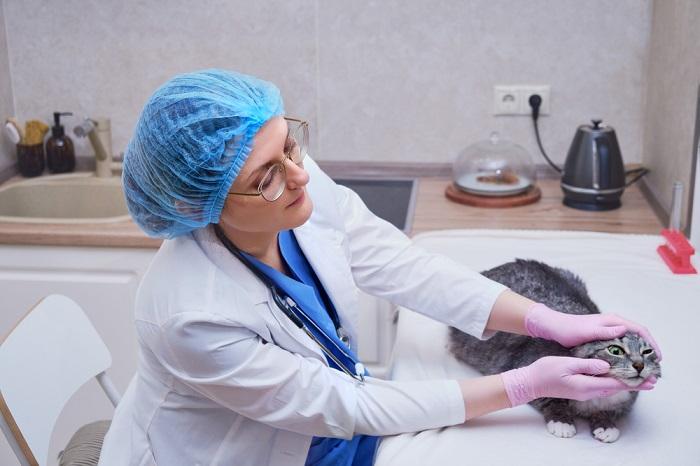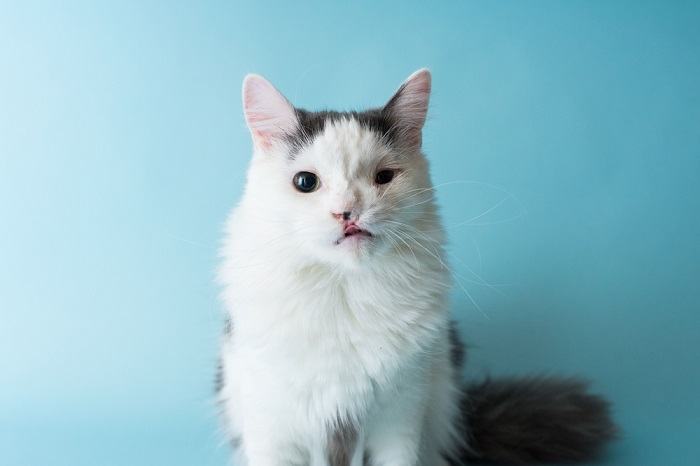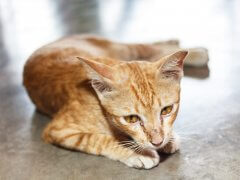
Eyelid agenesis in cats (also called “eyelid coloboma”) is a rare condition where a cat is born with some or all of its upper eyelid missing.
The eyelid is responsible for protecting the eye and keeping it moist by spreading the tear film when your cat blinks. A normal eyelid should sit smoothly on the cornea (the surface of the eye), stopping nearby hairs from touching the surface.
In cats with eyelid agenesis, the eyelid is missing, or not properly formed. This means the eye can become dry and prone to damage. Hairs may also rub the surface of the eye (a condition called “trichiasis”) which can be very painful.
The good news is that most cats who have their condition treated appropriately will go on to live happy and healthy lives.
Causes of Eyelid Agenesis
Eyelid agenesis is a congenital condition (a birth defect) meaning a condition that your cat is born with. Often multiple kittens in a litter are affected.
We don’t know exactly what causes the condition. It may be inherited or caused by a virus that affects the kittens while they are still in the womb.
Symptoms of Eyelid Agenesis
Cats with eyelid agenesis are missing some or all of their upper eyelid. This usually affects both eyes, most prominently on the lateral (outer) eyelids.
As it is a condition that cats are born with, it is often noticed when they are still young kittens. Along with the obvious defect in the eyelid, affected cats often go on to develop other clinical signs as a result of missing eyelids, such as:
- Irritation (squinting, redness, rubbing, pawing)
- Dry appearance on the surface of the eye
- Discharge from the eyes
- Corneal ulcers
- Changes in the appearance of their eyes (pigmentation, cloudiness, vascularization, and scarring); called “keratitis”
- Changes in vision
Diagnosis of Eyelid Agenesis in Cats

A veterinary ophthalmologist can determine how severe a cat’s eye agenesis is, and what steps are needed to resolve it.
The abnormal appearance of the eyelid is usually pretty easy to spot. However, cats with eyelid agenesis should be examined by a veterinary ophthalmologist to determine the severity, as it often requires specialist treatment.
It is not unusual for cats with eyelid agenesis to have other congenital abnormalities in their eyes, such as a condition called persistent pupillary membranes. A veterinary ophthalmologist will perform a thorough ophthalmic examination to check for any other issues.
Treatment of Eyelid Agenesis in Cats
Relieving the Symptoms
Medications can be used as a temporary measure to treat the symptoms of eyelid agenesis. These might include pain relief to relieve the discomfort, antibiotics to treat infection, and lubricants applied regularly to help keep the eye moist.
Treating Trichiasis
Many cats with eyelid agenesis will suffer from trichiasis (a condition where nearby eyelashes and hairs rub on the surface of the eye). These hairs need to be removed to prevent ongoing irritation, discomfort, and damage.
In very mild cases or in those with financial constraints, it may be possible to pluck these hairs every few months.
For permanent removal, freezing therapies (such as cryoepilation) can be used to permanently damage the hair follicles near the eyelid margin. Some cats may need more than one treatment to prevent the recurrence of the hairs, and complications can occur.
Surgery for Eyelid Agenesis

Surgery is the only cure for eyelid agenesis. Reconstruction usually involves tissue from the upper lip or another part of the face.
The only way to cure eyelid agenesis is surgical reconstruction of the lid. There are multiple techniques that can be used, depending on the individual case. The procedure usually involves taking tissue from the upper lip, or another part of the face, and using it to reconstruct the missing eyelid.
Prognosis of Eyelid Agenesis in Cats
Eyelid agenesis in cats is a treatable condition, and most cats will do well long-term if they receive appropriate treatment before the eye suffers permanent damage. However, it can be tricky to treat, and some cats will require more than one surgery to completely resolve the condition.
Without treatment, most cats will suffer ongoing discomfort and damage to the eye that will eventually lead to irreversible damage.
Preventing Eyelid Agenesis in Cats
We don’t know exactly what causes eyelid agenesis in cats and therefore it is difficult to know how to prevent it. As multiple kittens in a litter are often affected, it is likely that is a genetic condition. Therefore, it is recommended that affected cats are neutered so they are unable to breed.
It has also been suggested that eyelid agenesis could also occur due to a virus affecting the kittens in the womb. Therefore, you should ensure your cat is fully vaccinated prior to breeding.
Conclusion

While not always easy to treat, eyelid agenesis is a treatable condition and cats with it can lead happy lives once it is addressed.
Eyelid agenesis in cats is a rare condition that can cause lifelong discomfort and damage to the eyes. However, it is treatable, and the prognosis for cats who receive appropriate treatment is good.
If you are worried about your cat’s eyes, you should take them to see a veterinarian immediately.
Also Read: Cat Vaccinations: What You Need To Know?
Frequently Asked Questions
What causes eyelid agenesis in cats?
Feline eyelid agenesis is a congenital condition (or a birth defect), meaning it is something they are born with. We don’t know exactly what causes it. As multiple kittens in a litter are often affected, it is likely that it is genetic. However, it has also been suggested that it could occur to a virus that the kittens are exposed to in the womb.
Can cats live with eyelid agenesis?
Cats with eyelid agenesis must receive treatment from a veterinarian. With appropriate treatment (which may involve eyelid surgery), the prognosis is good.
Left untreated, most cats with eyelid agenesis will suffer continuous discomfort and damage to their eyes that can become irreversible.
Can cats be born without eyelids?
Yes! Although it is rare, cats can be born with a condition called “eyelid agenesis” (also called “eyelid coloboma”) where some or all of the upper eyelid is missing. Often multiple kittens in a litter will be affected.
Why is my cat's third eyelid not retracting?
Lots of conditions can cause your cat’s third eyelid to stick out. These can include problems in the eye, such as conjunctivitis, corneal ulcers, trauma, or even a mass affecting the third eyelid. It can also happen due to a problem affecting somewhere else in their body, such as diarrhea or dehydration.
If you notice a change in the appearance of your cat’s eyes you should get them checked by your vet straight away.







